Relationship between Renewable Biogas Energy Sources and Financial Health of Food Business Operators
Abstract
:1. Introduction
2. Research Methodology
2.1. Biogas Potential—Data Sources and Estimation Methods
2.2. Evaluation of Financial Condition—Selected Indicators
2.3. Relative Efficiency
3. Results
4. Conclusions
Author Contributions
Funding
Institutional Review Board Statement
Informed Consent Statement
Data Availability Statement
Conflicts of Interest
References
- Jalali Sepehr, M.; Haeri, A.; Ghousi, R. A cross-country evaluation of energy efficiency from the sustainable development perspective. Int. J. Energy Sect. Manag. 2019, 13, 991–1019. [Google Scholar] [CrossRef]
- Damyanova, S.; Beschkov, V. Biogas as a Source of Energy and Chemicals. In Biorefinery Concepts, Energy and Products; Intech Open: London, UK, 2020. [Google Scholar] [CrossRef]
- Li, W.; Ma, J.; Qiu, J.; Wang, S. Thermocells-enabled low-grade heat harvesting: Challenge, progress, and prospects. Mater. Energy 2022, 27, 101032. [Google Scholar] [CrossRef]
- Kit Leongab, Y.; Changabcd, J. Integrated role of algae in the closed-loop circular economy of anaerobic digestion. Bioresour. Technol. 2022, 360, 127618. [Google Scholar] [CrossRef]
- Circular Economy in Practice: A Value Loop for the Biogas, Substrate and Mushrooms Industry. Available online: https://ec.europa.eu/research-and-innovation/en/projects/success-stories/all/circular-economy-practice-value-loop-biogas-substrate-and-mushrooms (accessed on 22 July 2022).
- Winquist, E.; Van Galen, M.; Zielonka, S.; Rikkonen, P.; Oudendag, D.; Zhou, L.; Greijdanus, A. Expert Views on the Future Development of Biogas Business Branch in Germany, The Netherlands, and Finland until 2030. Sustainability 2021, 13, 1148. [Google Scholar] [CrossRef]
- Serwis Rzeczypospolitej Polskiej. Available online: https://www.gov.pl/web/klimat/polityka-energetyczna-polski-do-2040-r-przyjeta-przez-rade-ministrow (accessed on 24 July 2022).
- Igliński, B.; Buczkowski, R.; Iglińska, A.; Cichosz, M.; Piechota, G.; Kujawski, W. Agricultural biogas plants in Poland: Investment process, economical and environmental aspects, biogas potential. Renew. Sustain. Energy Rev. 2012, 16, 4890–4900. [Google Scholar] [CrossRef]
- Muradin, M.; Foltynowicz, Z. Potential for Producing Biogas from Agricultural Waste in Rural Plants in Poland. Sustainability 2014, 6, 5065–5074. [Google Scholar] [CrossRef]
- Sefeedpari, P.; Pudełko, R.; Jędrejek, A.; Kozak, M.; Borzęcka, M. To What Extent Is Manure Produced, Distributed, and Potentially Available for Bioenergy? A Step toward Stimulating Circular Bio-Economy in Poland. Energies 2020, 13, 6266. [Google Scholar] [CrossRef]
- Szyba, M.; Mikulik, J. Energy Production from Biodegradable Waste as an Example of the Circular Economy. Energies 2022, 15, 1269. [Google Scholar] [CrossRef]
- Nikiciuk, M. Potencjał ekologiczny i przyrostowy sektora biogazowni rolniczych w województwie podlaskim. Repozytorium Uniw. Białymstoku 2019, 98–117. [Google Scholar] [CrossRef]
- Ptak, M.; Skowrońska, A.; Pińkowska, H.; Krzywonos, M. Sugar Beet Pulp in the Context of Developing the Concept of Circular Bioeconomy. Energies 2022, 15, 175. [Google Scholar] [CrossRef]
- Klimek, K.; Kapłan, M.; Syrotyuk, S.; Bakach, N.; Kapustin, N.; Konieczny, R.; Dobrzyński, J.; Borek, K.; Anders, D.; Dybek, B.; et al. Investment Model of Agricultural Biogas Plants for Individual Farms in Poland. Energies 2021, 14, 7375. [Google Scholar] [CrossRef]
- REPowerEU: A Plan to Rapidly Reduce Dependence on Russian Fossil Fuels and Fast forward the Green Transition. Available online: https://ec.europa.eu/commission/presscorner/detail/en/IP_22_3131 (accessed on 3 August 2022).
- Kaltschmitt, M.; Hartmann, H. Biogaserzeugung und-Nutzung Energie Aus Biomass; Springer: Berlin/Heidelberg, Jermany, 2001; pp. 641–694. [Google Scholar] [CrossRef]
- Available online: https://www.nrel.gov/docs/legosti/fy97/26041.pdf (accessed on 23 December 2021).
- Wellinger, A.; Murphy, J.; Baxter, D. (Eds.) The Biogas Handbook. Science, Production and Applications; Woodhead Publishing Limited: Cambridge, UK, 2013. [Google Scholar]
- UlrichStohr, U.W.; Hees, N. Biogas Plants in Animal Husbandry. A Practical Guide; Deutsches Zentrum für Entr. ddungstechnologien–GATE: Eschborn, Germany, 1989. [Google Scholar]
- Steffen, R.; Szolar, O.; Braun, R. Feedstocks for Anaerobic Digestion. Vienna: University of Agricultural Sciences; Institute for Agrobiotechnology: Tulln, Austria, 1998. [Google Scholar]
- Angelis-Dimakis, A.; Biberacher, M.; Dominguez, J.; Fiorese, G.; Gadocha, S.; Gnansounou, E.; Guariso, G.; Kartalidis, A.; Panichelli, L.; Pinedo, I.; et al. Methods and tools to evaluate the availability of renewable energy sources. Renew. Sustain. Energy Rev. 2011, 15, 1182–1200. [Google Scholar] [CrossRef]
- Al Seadi, T. Good Practice in Quality Management of AD Residues from Biogas Production; IEA Bioenergy: Esbjerg, Denmark, 2002. [Google Scholar]
- Bank Danych Lokalnych: GUS. Available online: https://bdl.stat.gov.pl/BDL/dane/podgrup/temat (accessed on 23 December 2021).
- IEA Bioenergy. Available online: https://task37.ieabioenergy.com/files/daten-redaktion/download/Technical%20Brochures/Wastewater_biogas_grey_web-1.pdf (accessed on 31 January 2022).
- Bank Danych Lokalnych: GUS. Available online: https://stat.gov.pl/obszary-tematyczne/roczniki-statystyczne/roczniki-statystyczne/rocznik-statystyczny-rolnictwa-2013,6,7.html (accessed on 18 October 2021).
- Bank Danych Lokalnych: GUS. Available online: https://stat.gov.pl/obszary-tematyczne/roczniki-statystyczne/roczniki-statystyczne/rocznik-statystyczny-rolnictwa-2019,6,13.html (accessed on 18 October 2021).
- Martinát, S.; Dvořák, P.; Frantál, B.; Klusáček, P.; Kunc, J.; Kulla, M.; Mintálová, T.; Navrátil, J.; Dan van der Horst, D. Spatial Consequences of Biogas Production and Agricultural Changes in the Czech Republic after EU Accession: Mutual Symbiosis, Coexistence or Parasitism? Acta Univ. Palacki. Olomuc.–Geogr. 2013, 44, 75–92. [Google Scholar]
- Bharathirajaa, B.; Sudharsanaa, T.; Jayamuthunagaib, J.; Praveenkumarc, R.; Chozhavendhand, S.; Iyyappan, J. Biogas production—A review on composition, fuel properties, feed stock and principles of anaerobic digestion. Renew. Sustain. Energy Rev. 2018, 90, 570–582. [Google Scholar] [CrossRef]
- Zepter, J.M.; Engelhardt, J.; Gabderakhmanova, T.; Marinelli, M. Empirical Validation of a Biogas Plant Simulation Model and Analysis of Biogas Upgrading Potentials. Energies 2021, 14, 2424. [Google Scholar] [CrossRef]
- Average Sales Price of Electricity on the Competitive Market (Annual and Quarterly)—Prices, Indices—Energy Regulatory Office. Available online: https://www.ure.gov.pl (accessed on 18 October 2021).
- Available online: https://metropoliagzm.pl/wp-content/uploads/2022/02/IPA_GZM-Koncepcja-rozwoju-Odnawialnych-Zrodel-Energii-OZE-w-gminach-GZM-jako-jedno-z-narzedzi-osiagniecia-celu-Metropolii-samowystarczalnej-energetycznie.pdf (accessed on 25 July 2022).
- Farrell, M.J. The Measurement of Productive Efficiency. J. R. Stat. Soc. Ser. A 1957, 120, 253–290. [Google Scholar] [CrossRef]
- Mardani, A.; Zavadskas, E.K.; Streimikiene, D.; Jusoh, A.; Khoshnoudi, M. A comprehensive review of data envelopment analysis (DEA) approach in energy efficiency. Renew. Sustain. Energy Rev. 2017, 70, 1298–1322. [Google Scholar] [CrossRef]
- Shabanpour, H.; Yousefi, S.; Saen, R.F. Forecasting efficiency of green suppliers by dynamic data envelopment analysis and artificial neural networks. J. Clean. Prod. 2017, 142, 1098–1107. [Google Scholar] [CrossRef]
- Charnes, A.; Cooper, W.W.; Golany, B.; Seiford, L.M.; Stutz, J. Foundations of Data Envelopment. Analysis for Pareto-Koopman’s Efficient Empirical Production Functions. J. Econom. 1985, 30, 91–107. [Google Scholar] [CrossRef]
- Charnes, A.; Cooper, W.W.; Rhodes, E. Measuring the efficiency of decision making units. Eur. J. Oper. Res. 1978, 2, 429–444. [Google Scholar] [CrossRef]
- Urząd Regulacji Energetyki. Available online: https://www.ure.gov.pl/pl/urzad/informacje-ogolne/aktualnosci/10400,W-pierwszym-kwartale-2022-roku-srednia-cena-sprzedazy-energii-elektrycznej-na-ry.html (accessed on 26 July 2022).
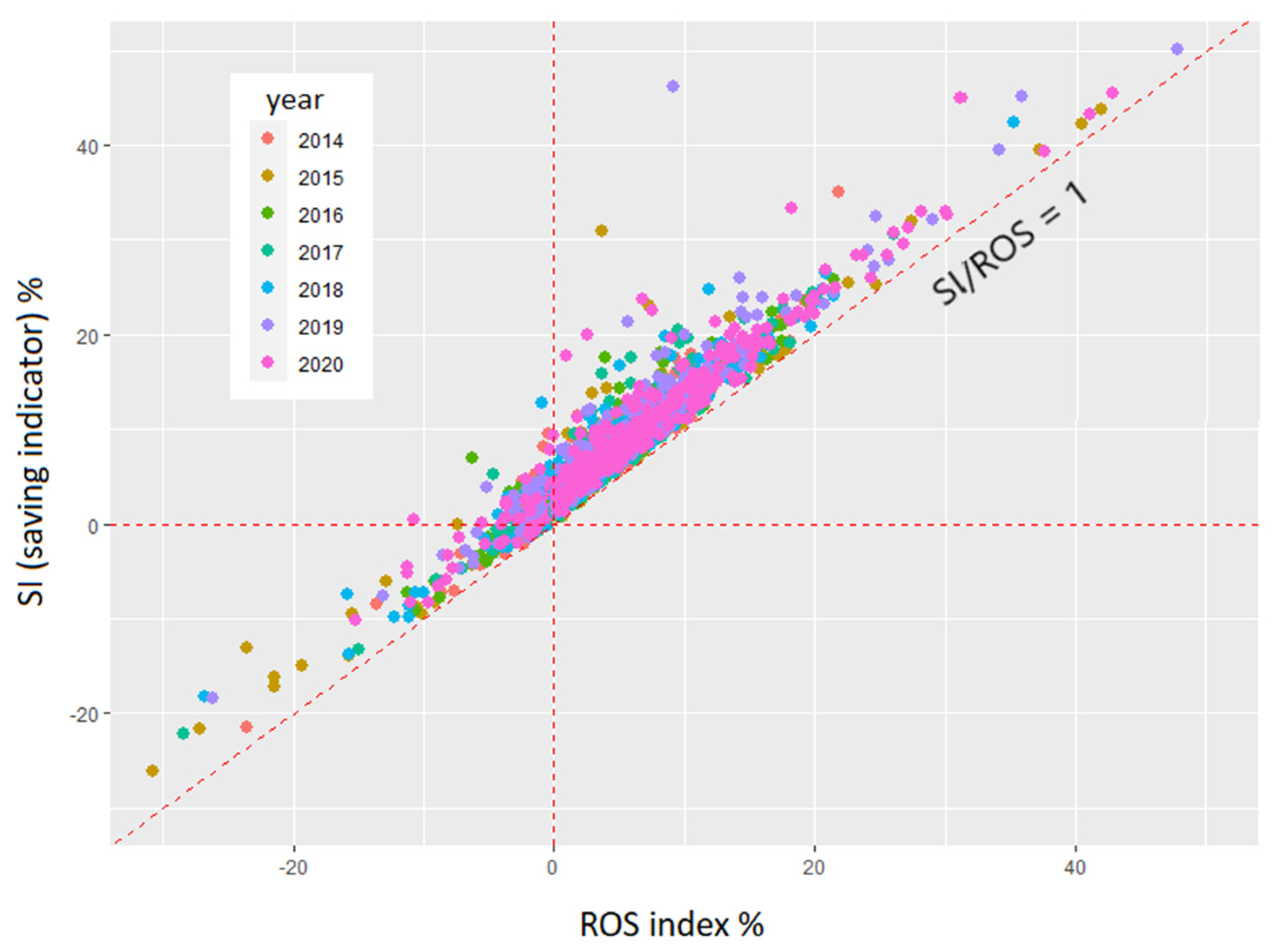
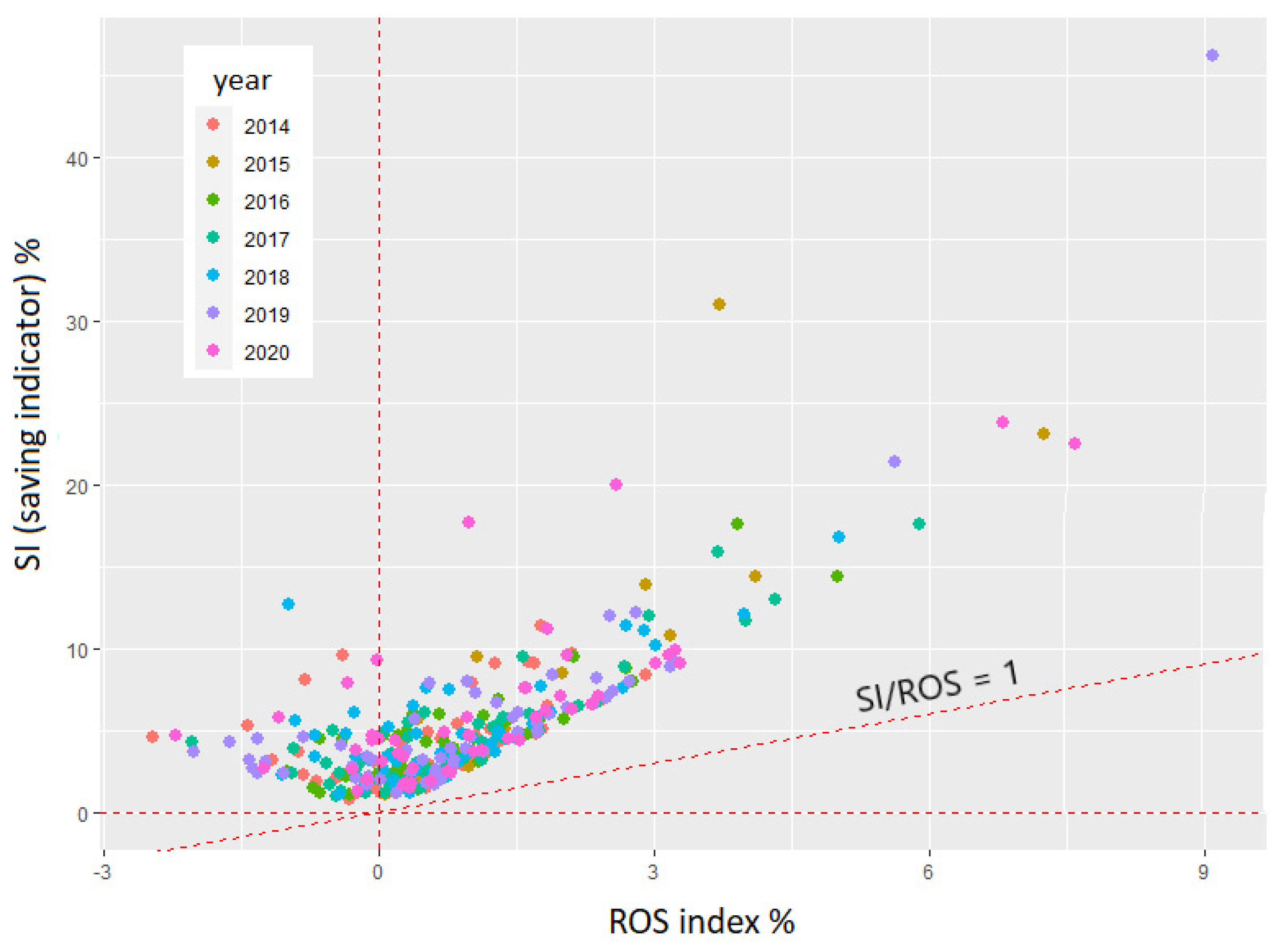

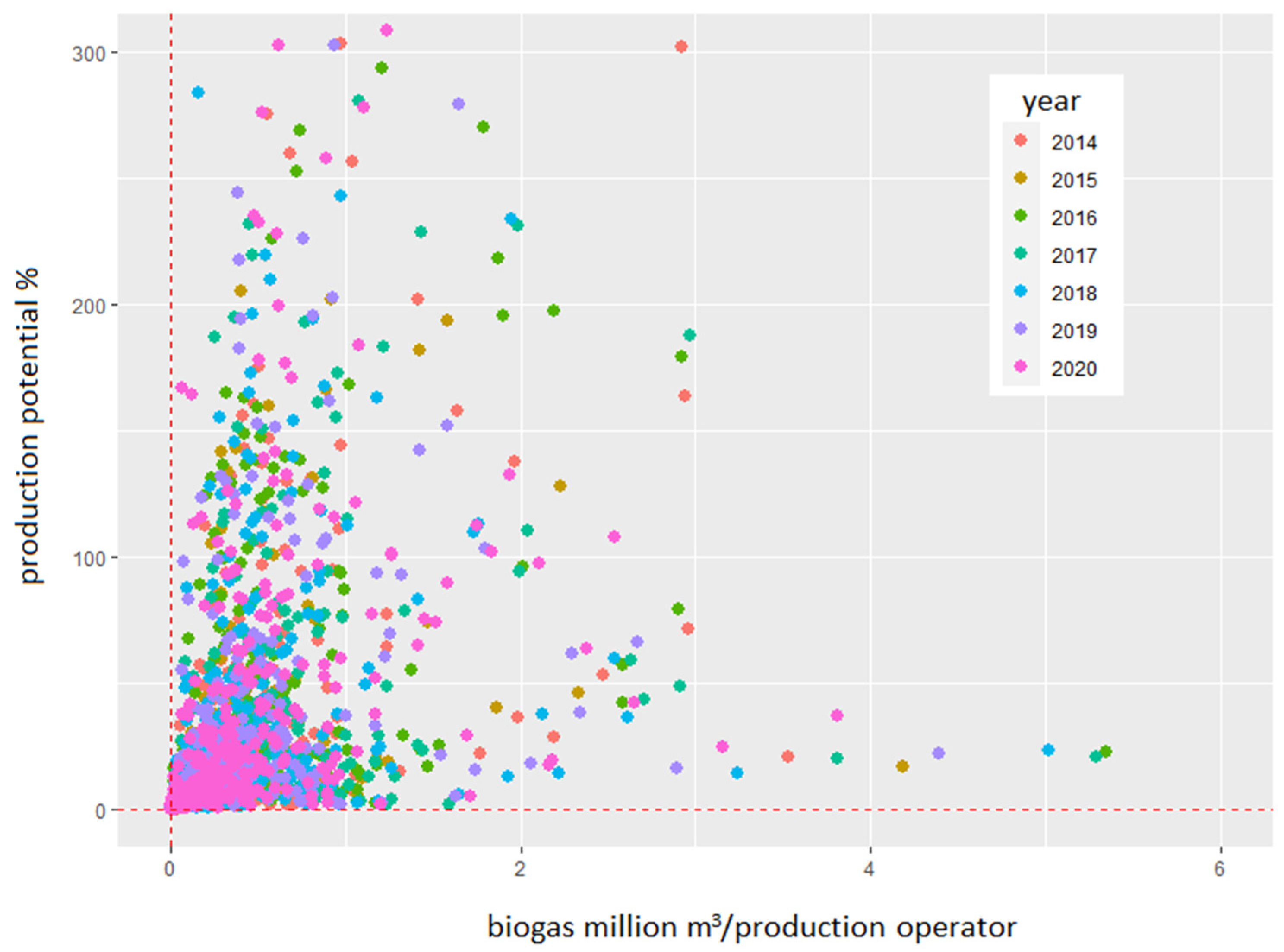
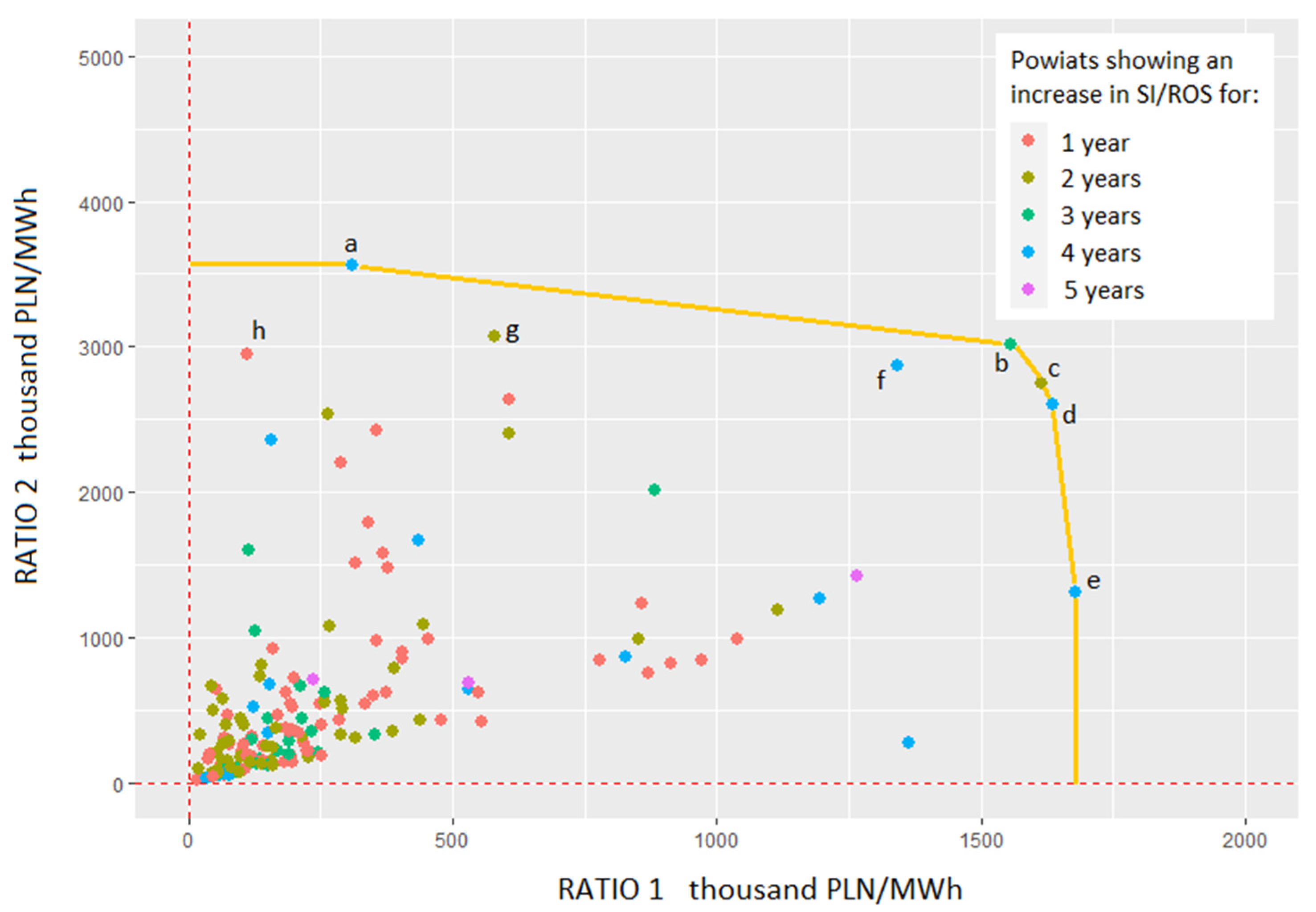
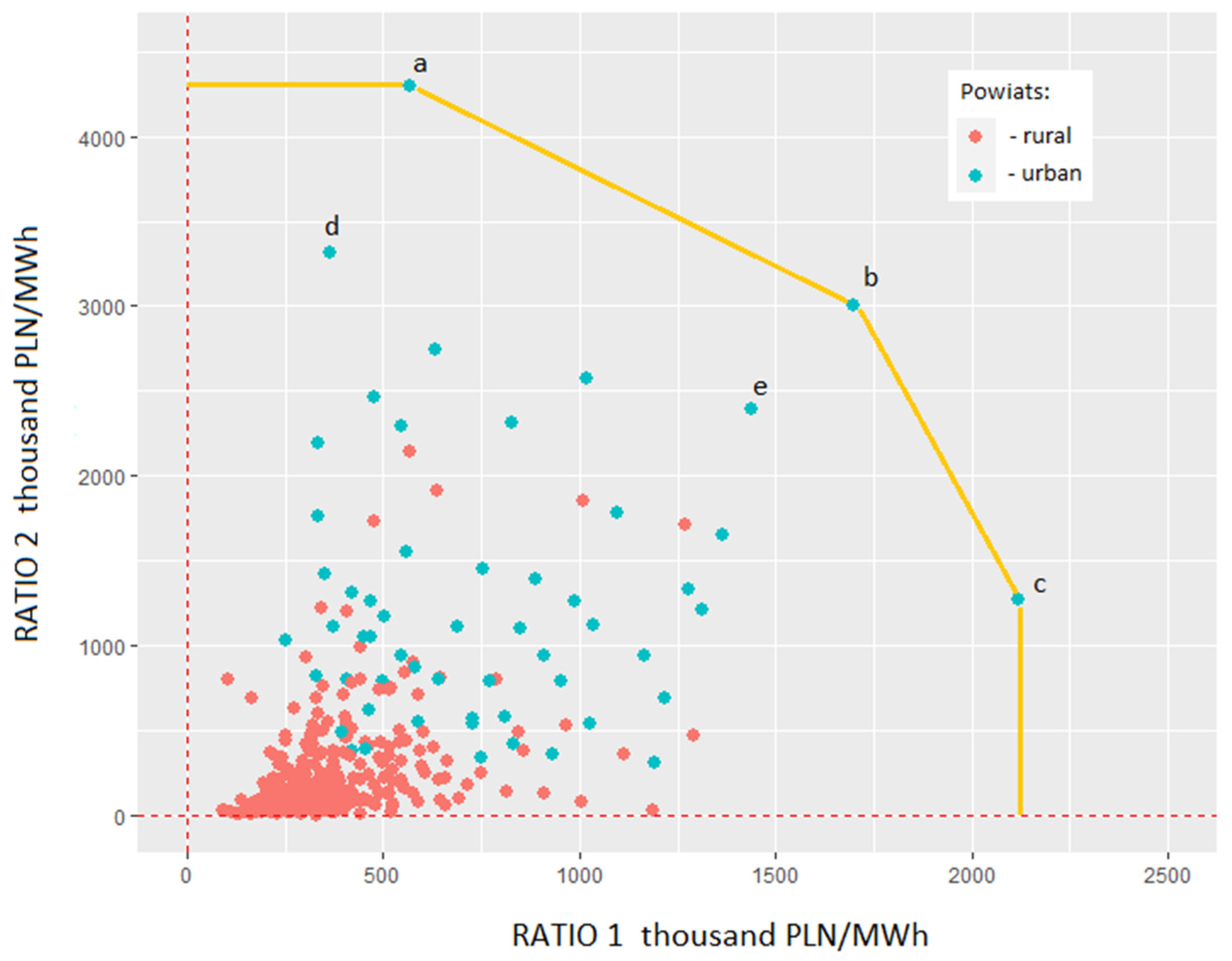

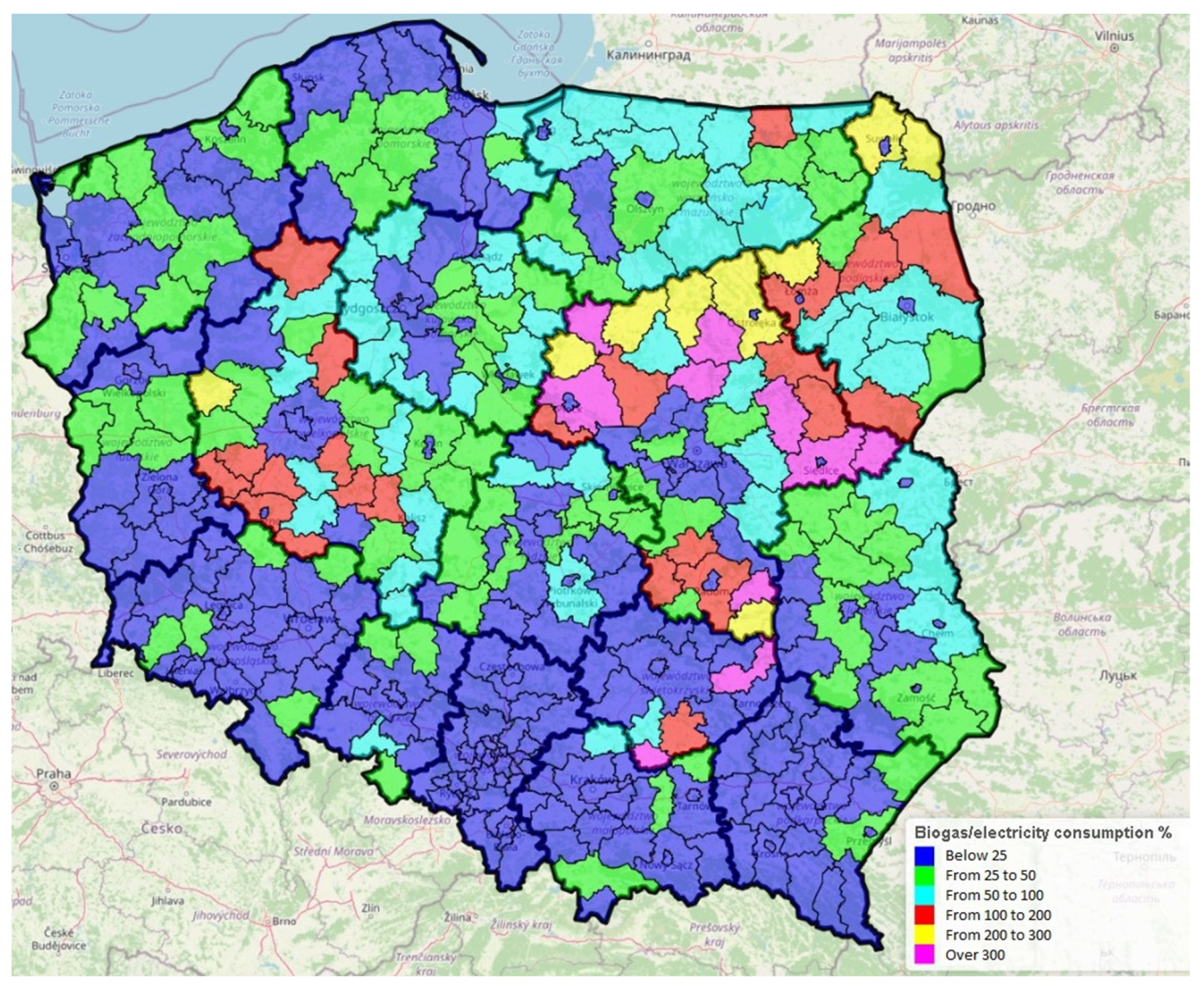
| Coverage of Electricity Requirements | 2014 | 2015 * | 2016 | 2017 | 2018 | 2019 | 2020 | total |
|---|---|---|---|---|---|---|---|---|
| >100% | 45 | 20 | 44 | 42 | 48 | 52 | 56 | 307 |
| 50–100% | 31 | 7 | 34 | 33 | 27 | 27 | 40 | 199 |
| 25–50% | 43 | 18 | 39 | 45 | 42 | 45 | 44 | 276 |
| 10–25% | 88 | 35 | 85 | 75 | 83 | 84 | 81 | 531 |
| <10% | 160 | 68 | 157 | 160 | 152 | 145 | 130 | 972 |
Publisher’s Note: MDPI stays neutral with regard to jurisdictional claims in published maps and institutional affiliations. |
© 2022 by the authors. Licensee MDPI, Basel, Switzerland. This article is an open access article distributed under the terms and conditions of the Creative Commons Attribution (CC BY) license (https://creativecommons.org/licenses/by/4.0/).
Share and Cite
Cierpiał-Wolan, M.; Stec-Rusiecka, J.; Twaróg, D.; Bilińska, K.; Dewalska-Opitek, A.; Wierzbiński, B. Relationship between Renewable Biogas Energy Sources and Financial Health of Food Business Operators. Energies 2022, 15, 5797. https://doi.org/10.3390/en15165797
Cierpiał-Wolan M, Stec-Rusiecka J, Twaróg D, Bilińska K, Dewalska-Opitek A, Wierzbiński B. Relationship between Renewable Biogas Energy Sources and Financial Health of Food Business Operators. Energies. 2022; 15(16):5797. https://doi.org/10.3390/en15165797
Chicago/Turabian StyleCierpiał-Wolan, Marek, Jolanta Stec-Rusiecka, Dariusz Twaróg, Katarzyna Bilińska, Anna Dewalska-Opitek, and Bogdan Wierzbiński. 2022. "Relationship between Renewable Biogas Energy Sources and Financial Health of Food Business Operators" Energies 15, no. 16: 5797. https://doi.org/10.3390/en15165797
APA StyleCierpiał-Wolan, M., Stec-Rusiecka, J., Twaróg, D., Bilińska, K., Dewalska-Opitek, A., & Wierzbiński, B. (2022). Relationship between Renewable Biogas Energy Sources and Financial Health of Food Business Operators. Energies, 15(16), 5797. https://doi.org/10.3390/en15165797






